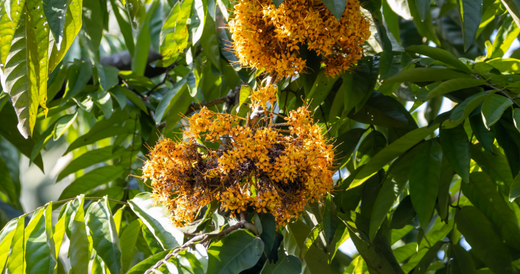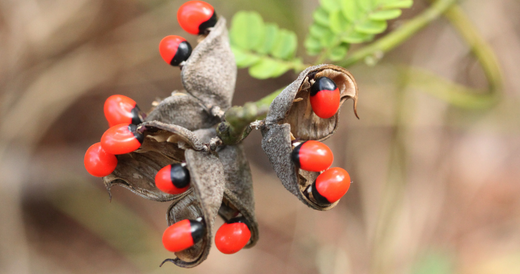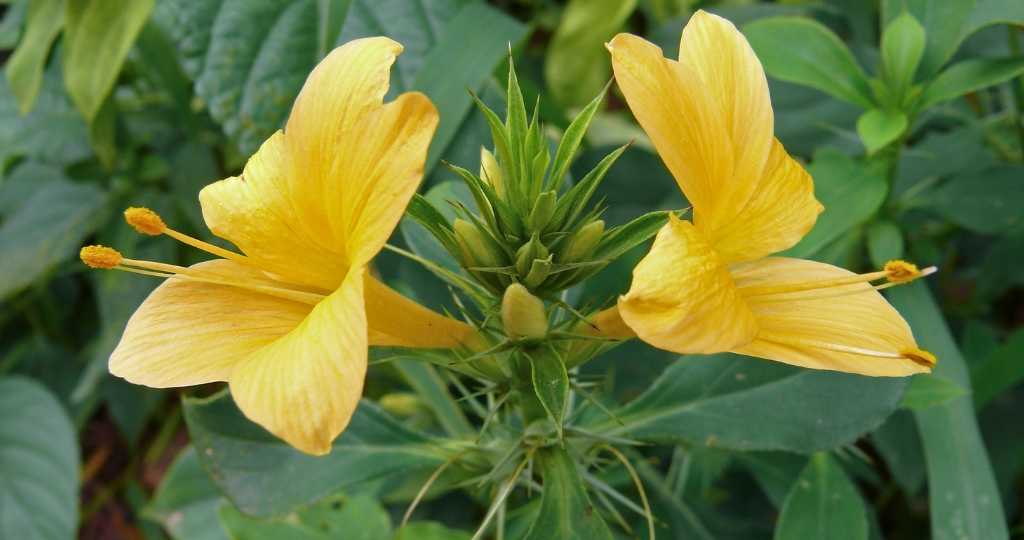
Ashoka [Sorrowless Tree]: 6 Benefits, Usage & Tips
An Introduction to Ashoka
The Ashoka plant, known as Saraca Indica, belongs to the Fabaceae family. It is a mid-sized evergreen tree growing up to 9 meters tall. The Ashoka is native to India and was first mentioned in the Ramayana epic over 2,500 years ago.
It is a flowering plant bearing bright orange-yellow flowers in dense clusters. These clusters bloom annually in February through April. Traditionally, the Ashoka tree is considered sacred in India and admired for its vibrant seasonal blossoming.
- Hindi Name: Ashok
- Sanskrit Name: Ashoka
- English Name: Sorrowless Tree
- Latin Name: Saraca Indica
Evidence Based Advantages of Ashoka
Here are the major Ashoka tree benefits:
- Anti-bacterial and anti-fungal - Studies have found extracts from the Ashoka tree fruit to inhibit the growth of bacteria like E. coli and fungi like Candida.
- Anti-diabetic - Animal studies show the plant's bark powder has anti-diabetic effects and can lower blood glucose levels.
- Anti-oxidant - The plant is rich in tannins and other phenolic compounds with strong antioxidant activities to help remove free radicals.
- Anti-inflammatory - Researchers have noted the anti-inflammatory effects of compounds isolated from Ashoka plant parts. This helps reduce swelling or irritation.
- Analgesic - Analgesic effects were found in studies using Ashoka extracts in rodent pain models, indicating potential pain-relieving properties.
- Anti-tumor - Specific cancer cell types were inhibited by Ashoka plant components in lab studies. This demonstrates anti-tumor and chemopreventative capabilities.
- Cardioprotective - Rodent studies demonstrate the heart-protecting effects of Ashoka extracts against tissue damage from depleted oxygen flow or medications.
- Hepatoprotective - Components protected against chemically induced liver damage in animal models. This points to Ashoka's valuable support for liver health.
- Anticonvulsant - Mice model experiments showed treatment with Ashoka extracts delayed onset and shortened duration of chemically induced convulsions.
- Anthelmintic - In veterinary lab trials, the plant showed deworming capabilities against harmful intestinal worms.

Source: Canva
1. Ashoka to Prevent Diabetes
The extracts from the Ashoka plant's bark, flowers, and seeds have anti-diabetic effects. The compounds pterostilbene, cinsitin, and homeostin, in particular, display abilities to lower blood glucose levels comparable to common oral diabetes medications. Researchers believe Ashoka components act by preserving functional beta cells in the pancreas, stimulating insulin release, improving cellular uptake of blood sugar, or through other protective pathways - all leading to normalized serum glucose levels. Supplementing at-risk groups like metabolic syndrome, prediabetics, or Type 2 diabetics with Ashoka bark powder shows much promise for safely regulating blood sugar long-term.
2. Ashoka to Remove Free Radicals
A prime source of tannins, flavonoids, sterols, and various phenolic acids, the Ashoka plant delivers powerful antioxidant constituents with proven free radical scavenging activity in both living systems and lab analysis. These plant chemicals can stabilize high-energy free radicals, stopping the chain reactions that damage healthy cell membranes, proteins, or DNA. Ashoka may also boost innate antioxidant enzymes like superoxide dismutase within red blood cells and tissues. Protecting the body's cells from oxidative stress helps prevent age-related deterioration, encourages proper cellular function, and upholds energy levels that free radical havoc depletion.
3. Ashoka to Reduce Swelling or Irritation
Multiple parts of Saraca asoca contain linoleic acid, ketosterols, and key phenolic components that curb inflammatory messaging molecules like TNF-alpha, IL-6, and COX-2, according to research. These anti-inflammatory pathways block signals that spark swelling and irritation linked with cases of chronic inflammation - a driver of numerous health disorders like heart disease, autoimmunity issues, arthritis, IBS, and certain skin conditions. For those suffering inflammatory problems, Ashoka supplementation may help ease discomfort, redness, and pain over the long run by disrupting unhealthy inflammatory processes.
4. Ashoka for Protecting the Heart
Analyzing myocardial ischemia-reperfusion injury and drug-induced cardiotoxicity in rodents, pre-treatment with Ashoka leaf or bark extracts displayed significant cardioprotection from cardiac tissue damage. Researchers noted the preservation of antioxidant status alongside improved heart cell membrane stability as mechanisms that reduced risk of arrhythmia, infarction, and death while supporting healthy cardiac repair processes. The plant's anti-inflammatory, antilipidemic, and antithrombotic activities also boost cardiovascular function. For upholding robust circulation and heart health - especially vital for the elderly or those prone to cardiac complications - incorporating Ashoka shows immense promise.

Source: Canva
5. Ashoka for Liver Health
Multiple animal poisonings and overdose experiments have demonstrated Saraca asoca's ability to conserve healthy liver tissue and function - even in the face of excess acetaminophen, alcohol, CCl4, high-fat diets, cadmium, and other chemical insults. Bioactive components enhanced detoxifying enzymes, promoted antioxidation and maintained membrane integrity - leading researchers to conclude Ashoka has broad hepatoprotective abilities against liver cell necrosis, fatty infiltration, fibrosis, and resultant compensation across interconnected organ systems. Supporting the body's main detoxification center this way has profound upstream benefits.
6. Ashoka to Prevent Harmful Intestinal Worms
In veterinary labs, Ashoka extracts killed parasitic nematode worms and were effective anthelmintics against harmful hookworms like Ancylostoma ceylanicum and bunostomum. Compounds like saponins likely rupture parasitic membranes once ingested, clearing infestations for improved nutrient absorption and alleviating infectious gastroenteritis symptoms.
The plant shows potential for sustainable community-level control of intestinal parasitic diseases prevalent in livestock and humans - especially children - within rural settings lacking access to synthetic chemical dewormers.
How Does Ashoka Work for Health Issues?
When confronted with health issues ranging from diabetes to parasitic infections, the Ashoka plant provides a diverse pharmacological bounty we’re still unraveling. Extracts seem to combat illness on multiple fronts – quelling out-of-control inflammation contributing to joint pain or heart disease flare-ups, eliminating foreign invaders like bacteria infiltrating our gut lining, discouraging cancer cell mutation and proliferation through antioxidant and gene expression modulation, and more.
Ashoka’s broad healing effects likely stem from several bioactive compounds working in synchrony; for example, ketosterols may cut swelling while flavonoids scavenge damaging free radicals and saponins rupture worm membranes. Harnessed appropriately and safely, Ashoka as complementary therapy boosts the body’s innate self-repair capabilities, facilitating physiological and psychological balance vital to wellbeing.
Other Plants:
Top Ways You Can Use Ashoka Herb
The following are the ways you can use Ashoka:
- Grind the Ashoka tree's bark into a restorative powder and mix it with antioxidant-rich raw honey to create a medicinal jam.
- Simmer the bark in water to produce a therapeutic tea-like decoction, then mix with warming milk to produce a comforting elixir.
- The Ashoka tree has been used for centuries in Indian wellness traditions to create preparations like Asokarishta and Asokaghrita.
Demystifying The Top Ashoka Myths and Ashoka Facts

Source: Canva
Here's presenting the myths and facts associated with Ashoka:
Facts About Ashoka
- An evergreen tree growing up to 30 meters tall with extensive root systems
- Compound leaves comprised of 5-7 oval leaflets arranged alternately along branches
- Beautiful clusters of fragrant, orange-yellow flowers bloom annually from February-April
- Flowers grow in dense flower bunches, each containing up to 100 blossoms
- The fruit capsule ripens up to a year after flowering and is filled with flat brown seeds
- Considered a sacred tree in India, it is planted near temples and praised for its seasonal bloom
- Features diverse medicinal usage in Ayurvedic and Siddha traditional healing practices
- Herbal remedies utilise the bark, flowers, seeds, and leaves to harness Ashoka’s bioactive plant compounds
- Therapeutic applications target diabetes, pain, inflammation, liver health, women’s reproductive health issues, bacterial infections, and more
Other Plants:
Myths About Ashoka
- Ashoka flowers bloom precisely when struck by an arrow from Kamadeva, the god of love
- Its vibrant spring flowerings follow seasonal cues like temperature, sunlight, and rainfall patterns
- While majestic and spiritually symbolic, proximity alone provides no special powers
- Modern assays show bioactivity across Ashoka extracts of varying taste profile
Tips on Growing Ashoka at Home
Growing the Ashoka plant at home can be a rewarding experience, adding a touch of natural beauty to your surroundings. To ensure its successful growth, consider the following tips. First, choose a suitable location with well-draining soil and partial shade, as the Ashoka plant thrives in these conditions. When planting, ensure the soil is rich in organic matter. Water the plant consistently, keeping the soil evenly moist but not waterlogged.
It's advisable to fertilize during the growing season to promote healthy growth. Pruning can be done to maintain a desired shape and encourage branching. Be mindful of pests and diseases; inspect the plant regularly and treat any issues promptly. Additionally, providing support as the plant grows helps prevent breakage. Overall, with proper care and attention to its specific needs, the Ashoka plant can flourish and bring natural charm to your home environment.
Our Thoughts
Ashoka, the "Sorrowless Tree," is a revered Ayurvedic herb with a rich history of traditional medicinal use. Its therapeutic properties offer a holistic approach to wellness. By understanding its cultivation, usage, and potential benefits, one can embrace the holistic wisdom that this ancient herb brings to the realm of
FAQs
Q1. How do I cultivate Ashoka at home?
Choose a well-draining location with partial shade, rich organic soil, and consistent watering. Prune as needed for optimal growth.
Q2. What are the medicinal uses of the Ashoka herb in Ayurveda?
Ashoka traditionally addresses women's health issues, promoting hormonal balance and easing conditions such as menstrual discomfort.
Q3 Can Ashoka be consumed directly for its medicinal benefits?
Generally, it's used in the form of herbal supplements or decoctions. Consult with an Ayurvedic practitioner for appropriate dosage and usage.
Q4. Are there any side effects associated with Ashoka herb consumption?
When used as directed, Ashoka is generally considered safe. However, consulting with a healthcare professional is advisable to avoid potential interactions or adverse effects.
Q5. How long does it take for the Ashoka plant to mature and flower?
The time for maturity can vary, but typically, Ashoka plants start flowering after a few years of growth under favorable conditions.
Q6. Can Ashoka be grown in containers or pots?
Ashoka can be cultivated in large containers or pots, provided they offer sufficient space for root development and proper drainage. Regular care is essential for container-grown Ashoka plants.






